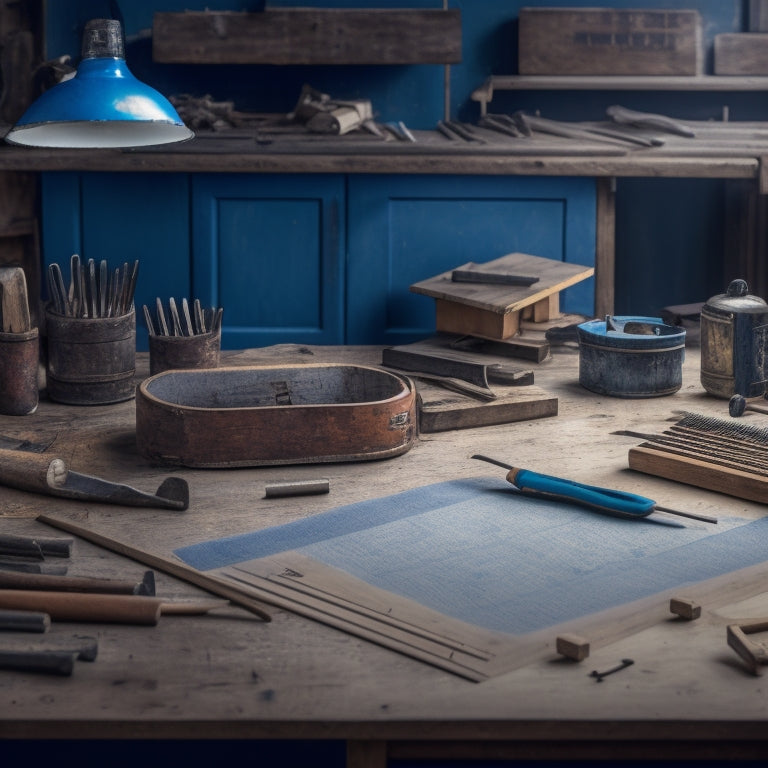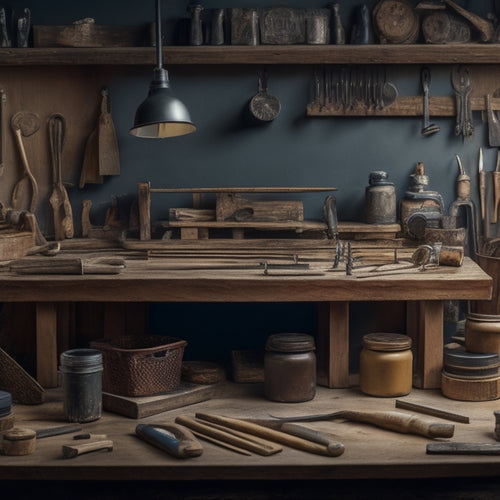
Essential Tools for Woodworking Project Planning Success
Share
To guarantee woodworking project planning success, you'll need to equip yourself with the right tools. Start by utilizing project management software with collaboration features to streamline communication and progress tracking. Leverage design software to create detailed 2D and 3D designs, and optimize cuts with cut list and materials organizers to reduce waste. Calendars will help you schedule tasks and manage your time effectively, while budgeting and cost estimators assure you stay financially on track. With measurement and conversion apps, collaborative workspaces, and woodworking project templates, you'll be well on your way to planning like a pro. Now, discover the full range of tools that will take your projects to the next level.
Key Takeaways
• Utilize project management software with collaboration features to streamline communication and track progress.
• Leverage design software for detailed 2D and 3D designs, and virtual reality simulations to visualize projects accurately.
• Implement cost estimation and resource management tools to break down material costs, allocate tooling expenses, and negotiate with suppliers.
• Employ efficiency tools like cut optimization software and task organization to prioritize tasks, allocate time effectively, and minimize waste.
• Access collaborative workspaces and measurement apps to ensure accurate calculations, track time, and analyze data for project success.
Project Management Software Options
You'll want to explore various project management software options to streamline your woodworking project planning process, efficiently organizing tasks, and tracking progress. This will enable you to stay on top of your project's scope, timeline, and budget.
When selecting a software, consider one that facilitates project collaboration, allowing you to invite team members or stakeholders to participate in the planning process. This guarantees everyone is on the same page, reducing miscommunication and errors.
Additionally, look for software that supports resource allocation, enabling you to assign tasks and materials to specific team members or vendors. This feature helps you optimize your workflow, preventing bottlenecks and delays.
With the right project management software, you'll be able to create and manage tasks, set deadlines, and track progress in real-time. This visibility will empower you to make data-driven decisions, securing your woodworking project stays on track and meets your desired outcome.
Design and Visualization Tools
When planning your woodworking project, you'll want to choose the right design and visualization tools to bring your ideas to life.
You'll need software that allows you to create detailed 2D designs, and possibly even 3D models, to visualize your project from every angle.
2D Design Software
How can design software streamline your woodworking project planning process by transforming your ideas into precise, visually stunning designs? By utilizing design software, you can create detailed project sketches, explore virtual reality simulations, and even integrate with CNC machines to bring your designs to life. This software also provides access to woodworking tutorials, helping you refine your skills and avoid costly mistakes.
Here's a breakdown of the benefits of design software in woodworking project planning:
| Feature | Benefit | Example |
|---|---|---|
| Project Sketching | Create detailed 2D and 3D designs | Visualize your woodworking project from multiple angles |
| Virtual Reality Simulations | Explore and interact with your design in a virtual environment | Test and refine your design before cutting a single piece of wood |
| CNC Machine Integration | Send designs directly to CNC machines for precision cutting | Streamline your workflow and reduce errors |
| Woodworking Tutorials | Access video tutorials and guides for various woodworking techniques | Improve your skills and confidence in the workshop |
| Design Collaboration | Share and collaborate on designs with others in real-time | Work with clients or team members to finalize designs |
3D Model Rendering
By leveraging 3D model rendering, woodworking project planners can transform their 2D designs into stunning, photorealistic 3D visualizations that accurately depict the final product's textures, colors, and intricate details.
This technology enables you to create immersive experiences, allowing clients and stakeholders to explore and interact with the design in a more engaging and realistic way.
With 3D model rendering, you can create virtual reality simulations that simulate the building process, helping you identify potential issues and make necessary adjustments before moving to the construction phase.
Moreover, augmented reality planning capabilities enable you to overlay digital models onto real-world environments, giving you a better understanding of how the final product will fit and function in its intended space.
This allows you to make more informed design decisions, reducing the risk of errors and costly rework.
Cut List and Materials Organizers
You'll streamline your woodworking project planning process by creating a cut list and materials organizer, an important step that helps make sure you have all the necessary components before starting your project. This tool is vital for inventory tracking, making sure you have all the required materials and quantities.
With a cut list, you'll avoid last-minute trips to the store or online marketplaces, saving you time and money. A well-organized cut list also enables you to optimize your cuts, reducing waste and maximizing the use of your materials. This is particularly significant when working with expensive or specialty woods.
By planning your cuts strategically, you'll minimize scrap and make the most of your resources. Consider using software or apps specifically designed for cut optimization to help you generate the most efficient cutting plan.
Task Scheduling and Calendars
With your cut list and materials organized, it's time to turn your attention to scheduling the tasks involved in bringing your woodworking project to life, and a calendar is an essential tool in this process. A well-planned calendar helps you prioritize tasks, allocate time, and stay on track, ensuring efficient project planning and time management.
By breaking down your project into smaller, manageable tasks, you can create a realistic timeline and avoid last-minute rushes. Here's an example of how you can organize your tasks using a calendar:
| Task | Duration | Deadline |
|---|---|---|
| Design and planning | 2 days | 3/10 |
| Material preparation | 1 day | 3/12 |
| Assembly | 3 days | 3/15 |
| Sanding and finishing | 2 days | 3/17 |
| Final assembly and quality control | 1 day | 3/19 |
Budgeting and Cost Estimators
As you plan your woodworking project, you'll need to establish a realistic budget to guarantee its success.
To do this, you'll want to accurately estimate the costs involved. This involves breaking down material costs, estimating labor hours, and allocating tooling expenses.
Material Cost Breakdown
Estimating material costs accurately is vital to staying within budget, and a detailed breakdown of these expenses helps you identify areas for potential savings.
To create an effective material cost breakdown, start by categorizing your materials into lumber, hardware, finishes, and other relevant groups. Then, research and record the costs of each item, including quantities and unit prices. This will give you a clear picture of where your money is going and help you pinpoint opportunities for cost savings.
When sourcing materials, don't be afraid to negotiate with suppliers to get the best prices. Building relationships with suppliers can lead to better deals and more flexible payment terms. Additionally, consider buying in bulk or using alternative materials to reduce costs.
Effective budget management is essential in woodworking project planning, and a detailed material cost breakdown is a key component of that. By staying on top of your material costs, you can make informed decisions about your project and avoid costly surprises down the line.
Labor Hour Estimation
You'll need to allocate time and resources for each task in your woodworking project, which is where labor hour estimation comes in - a process that helps you accurately budget for the human effort required to complete each phase of your project. This essential step guarantees you have a realistic understanding of the time and resources needed to bring your project to life.
To estimate labor hours effectively, consider the following factors:
-
Task complexity: Break down intricate tasks into smaller, manageable chunks to accurately estimate the time required.
-
Skill level: Consider the expertise level of the person performing the task, as more experienced individuals may complete tasks faster.
-
Tooling and equipment: Factor in the time spent setting up and using specialized tools or equipment.
- Contingency planning: Pad your estimates by 10-20% to account for unexpected delays or setbacks.
Tooling Expense Allocation
Frequently, woodworkers overlook the importance of allocating tooling expenses, but accurately budgeting for these costs is vital to avoiding financial surprises down the line. As you plan your woodworking project, you'll need to take into account the tools and equipment required to complete each task. This is where cost assignment comes into play. You'll need to assign a specific cost to each tool or piece of equipment, making sure you're accounting for every expense.
Effective resource management is key in this step. You'll need to identify the tools you already have, those you need to purchase, and those you can rent or borrow. By categorizing your tools and equipment, you'll be able to allocate costs accurately and make informed decisions about where to invest your resources.
For instance, if you're working on a project that requires a specialized router, you'll need to factor in the cost of purchasing or renting that tool. By doing so, you'll avoid overspending and guarantee your project stays within budget. By assigning tooling expenses accurately, you'll be able to complete your project efficiently and effectively, while also maximizing your resources.
Measurement and Conversion Apps
With a smartphone by your side, measurement and conversion apps can instantly provide accurate calculations, saving you time and reducing errors in your woodworking projects. You can easily access a range of digital tools that guarantee unit conversion accuracy, eliminating the risk of human error.
Here are some essential measurement and conversion apps to contemplate:
-
Unit Converter: Quickly convert between different units of measurement, such as inches to centimeters or feet to meters.
-
Angle Calculator: Calculate precise angles for your woodworking projects, ensuring accurate miter cuts and joints.
-
Digital Tape Measure: Use your smartphone's camera to measure rooms, objects, or materials with high accuracy.
- Fraction Calculator: Simplify fraction calculations, making it easy to work with complex measurements and conversions.
Collaborative Project Workspaces
In collaborative project workspaces, designers and woodworkers can share and manage project details in real-time, streamlining communication and making certain everyone is on the same page. You can invite team members or clients to join the workspace, where you can assign tasks, track progress, and comment on project elements. With virtual collaboration, you can work with others remotely, reducing miscommunication and increasing productivity.
You can customize your workspace to fit your project's unique needs, adding or removing features as necessary. Real-time editing allows you to see changes as they happen, making certain that everyone is working with the most up-to-date information.
Project visualization tools enable you to create 2D and 3D models, giving you a clear understanding of your project's layout and design. This feature is especially useful for complex projects, where mistakes can be costly. By using a collaborative project workspace, you can make sure that your project stays on track, and that everyone involved is working towards the same goal.
Woodworking Project Templates Hub
You can access a comprehensive library of woodworking project templates in the hub, where you'll find pre-designed plans and layouts for various projects, from simple cutting boards to complex cabinetry. This extensive collection saves you time and effort by providing a solid foundation for your projects. With these templates, you can focus on the finer details and avoid starting from scratch.
Here are some benefits of using the woodworking project templates hub:
-
Project template customization: Easily modify templates to fit your specific needs and preferences.
-
Resource sharing within templates: Access a shared repository of materials, tools, and techniques to make certain consistency across your projects.
-
You can search and filter templates by project type, skill level, or material, making it easy to find the perfect template for your next project.
- The hub is constantly updated with new templates and resources, ensuring you stay up-to-date with the latest woodworking trends and techniques.
Time Tracking and Analytics Tools
Efficient time tracking and analytics tools help you pinpoint areas for improvement, optimize your workflow, and make data-driven decisions to maximize your woodworking project's success. With these tools, you can accurately track how much time you spend on each task, identify bottlenecks, and adjust your workflow to boost efficiency. By monitoring your progress, you'll be able to refine your project timeline, allocate resources more effectively, and stay on track.
You'll also gain valuable insights into your productivity through detailed analysis. By identifying which tasks take up the most time and resources, you can optimize your workflow to achieve more in less time. This data-driven approach will help you streamline your process, eliminate waste, and allocate your resources more efficiently.
With time tracking and analytics tools, you'll be able to refine your woodworking project plan, improve your workflow, and achieve greater success. By leveraging these tools, you'll be able to take your woodworking projects to the next level and deliver high-quality results on time and within budget.
Frequently Asked Questions
How Do I Prioritize Tasks for a Complex Woodworking Project?
You tackle complex woodworking projects by breaking them down into manageable tasks, then prioritize them using the Eisenhower Matrix, ensuring you're focusing on the most critical tasks first, and making the most of your time.
What Are Common Mistakes to Avoid in Project Planning?
When planning a complex woodworking project, you'll want to avoid common mistakes like poor time management, leading to delays, and inadequate resource allocation, causing budget blowouts.
Can I Use Woodworking Project Planning Tools for Small Projects?
You can definitely use woodworking project planning tools for small projects, even if it's just quick sketches to visualize your idea or organized lists for material sourcing - it'll help you stay focused and efficient.
How Do I Handle Unexpected Changes to My Project Plan?
Ironically, you thought you had it all planned out, but life had other plans! You'll need adaptability strategies and flexibility techniques to adjust to unexpected changes. Adjusting timelines and using problem-solving approaches will help you stay on track and salvage your project.
Are There Any Free Woodworking Project Planning Tools Available?
You'll find several free woodworking project planning tools online, including budget management apps like Google Sheets and design software like Tinkercad, SketchUp Free, and Fusion 360 for personal use, to help you stay organized and on track.
Related Posts
-

What to Look for in a Pegboard Tool Storage Kit
When shopping for a pegboard tool storage kit, you need a system that combines customized organization, sturdy durabi...
-

Top 5 Small Tool Organizers for Your Workshop
You're looking to optimize your workshop's efficiency with high-quality small tool organizers. Compact storage soluti...
-

Building Garage Shelves in 7 Easy Steps
You're about to convert your garage into a highly functional storage space by building custom shelves in just 7 easy ...


